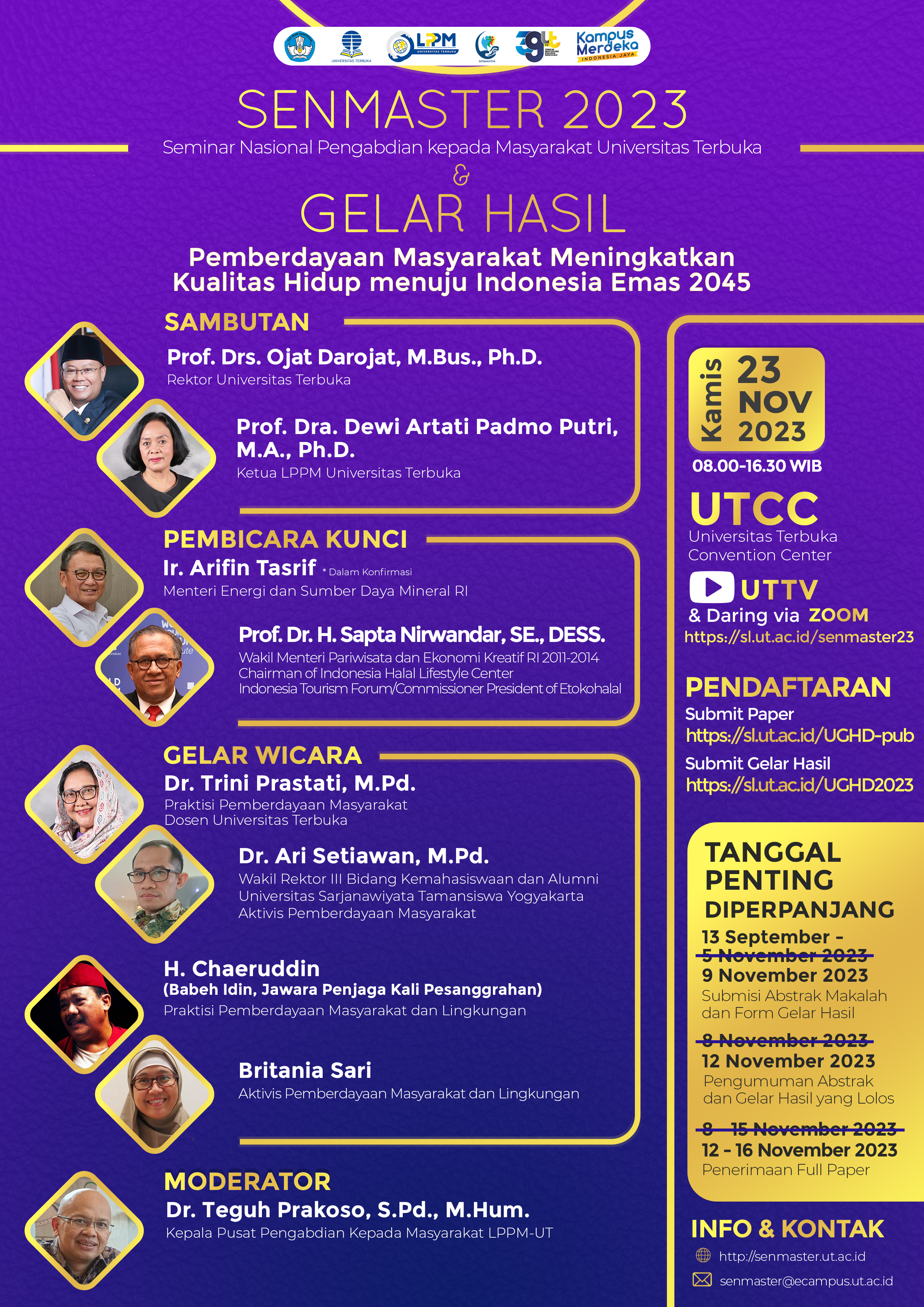Abstract
Jatimulyo sub-district has 34 wood craftsmen whose main products are furniture, doors, windows, tables, cupboards, various types of chairs, and various tools. As a village with a high number of craftsmen, there is a high amount of wood waste generated. So far, the waste has only been used as fuel for cooking or burned, thus becoming an environmental burden. Efforts and assistance are needed to utilize wood waste more effectively and have high selling power. The solution to overcome these problems is to provide intensive assistance for 4 months which was attended by 19 wood craftsmen from various hamlets in Jatimulyo village Dlingo Bantul Yogyakarta. Before the training was conducted, initial knowledge was given about goods on the market made from wood waste. Then intensive training was given directly and continued through WA Group to monitor the progress of the trainees' production.
The results of the mentoring were an increase in the knowledge and skills of the wood craftsmen in processing wood waste into goods with high selling power. The interior shape of the aesthetic house is by utilizing square pieces of wood and forming them into interior elements. The selected wood will be installed in a mold or mall that has been made to a certain size. The results of this aesthetic interior have a selling price of 90,000 to 250,000 per m2 and are in great demand by people who love buildings with classic interiors. Previously, the selling price of wood waste made into charcoal was only 3500 / kg so that there was a significant increase in the selling power of wood waste. Based on pretest and postest scores, the knowledge and skills of the community in processing wood waste increased to 82%. Improving community welfare needs to be optimized through basic skills that are owned by the community. Wood that has been cultivated by the community is able to become the main source of income for the community both from the main material of wood and its waste.
Keywords: wood waste utilization, home interior, functional crafts, Jatimulyo
References
Batubara, R., Basyuni, M., Iswanto, A. H., Slamet, B., Susilowati, A., Elfiati, D., Ulfa, M., & Pebriansyah, R. (2020). Pelatihan Pembuatan Produk Kerajinan Berbahan Ranting Kayu Mangrove. Prosiding Konferensi Nasional Pengabdian Kepada Masyarakat Dan Corporate Social Responsibility (PKM-CSR), 3(01), 179–183. https://doi.org/10.37695/pkmcsr.v3i0.894
Dewanti, F. D., Guniarti, G., Sulistyono, A., Koentjoro, Y., & Liliek, L. (2021). Pengembangan dan peningkatan kualitas usaha kerajinan berbasis limbah kayu jati. Jurnal Inovasi Hasil Pengabdian Masyarakat (JIPEMAS), 4(1), 118. https://doi.org/10.33474/jipemas.v4i1.9108
Dewi, M.H.U., Fandeli, Chafid, Baiquni, M. (2013). Pengembangan Desa Wisata Berbasis Partisipasi Masyarakat Lokal di Desa Wisata Jatiluwih Tabanan, Bali. Kawistara, 3 (2). 117. https://doi.org/10.22146/kawistara.3976
Eskak, E. (2016). Pemanfaatan Limbah Ranting Kayu Manis (Cinnamomun Burmanii) untuk Penciptaan Seni Kerajinan dengan Teknik Laminasi. Dinamika Kerajinan Dan Batik: Majalah Ilmiah, 31(2), 65. https://doi.org/10.22322/dkb.v31i2.1068
Fajrie, M., Adi Pradana, B., Rowi, M. Y., Ihsan, L. N. H., Iskandar, Z. A., & Faizin, N. (2022). Pemanfaatkan Limbah Kayu Menjadi Kerajinan Fungsional Dan Bernilai Estetik Di Desa Bugel. Journal of Dedicators Community, 6(3), 321–326. https://doi.org/10.34001/jdc.v6i3.2500
Jumawan, F., & Yusuf Ali, M. (2020). Usaha Kreatif Pengolahan Limbah Kayu di Kabupaten Soppeng. Jurnal Pendidikan Dan Pengabdian Masyarakat, 3(3), 149–153. https://jurnalfkip.unram.ac.id/index.php/JPPM/article/view/1968
Kurnianti, A. . (2018). Strategi Komunikasi Pemasaran Digital Sebagai Penggerak Desa Wisata Kabupaten Wonosobo Provinsi Jawa Tengah. Jurnal Riset Komunikasi, 1(1). 180-190. https://doi.org/10.24329/jurkom.v1i1.24
Kusumastuti, R., Silalahi, M., Asmara, A. Y. et al. (n.d.). Finding the context indigenous innovation in village enterprise knowledge structure: a topic modeling. . . J Innov Entrep, 11, 19. https://doi.org/10.1186/s13731-022-00220-9
Ni Luh Putu Yesy Anggreni, I Putu Eka Indrawan, & Pande Komang Suparyana. (2022). Wirausaha Masyarakat Desa Mendoyo Kabupaten Negara Dalam Pemanfaatan Limbah Kayu Sebagai Produk Kerajinan Tangan Yang Ramah Lingkungan. Jurnal Pengabdian Kepada Masyarakat Widya Mahadi, 2(2), 8–16. https://doi.org/10.59672/widyamahadi.v2i2.1951
Savitri, Safitri, R., & Rachmat, G. (2021). Pemanfaatan Limbah Kayu sebagai Produk Cenderamata bagi Keluarga. Panggung, 31(1), 1–14.
Setyaningrum, F., Siswantari, H., Simatupang, L. L., & Fitriasari, P. D. (2019). Hidden Curriculum Design of Traditional Art Community Rampak Kendang. International Journal of Visual and Performing Arts, 1(2), 90–97. https://doi.org/10.31763/viperarts.v1i2.65
Siswantari, H., & Sularso, S. (2020). Pelatihan Tari dan Rias Panggung di Sanggar Tari Langen Budoyo Desa Jatimulyo Dlingo Bantul Yogyakarta. Seminar Nasional Hasil Pengabdian Kepada Masyarakat, November, 525–534.
Sudiryanto, G., & Suharto, S. (2020). Analisa Jenis Limbah Kayu Di Jepara. Jurnal DISPROTEK, 11(1), 47–53. https://doi.org/10.34001/jdpt.v11i1.1163
Sulistyaningrum, D. E., Amin, M., Suryanto, A., Yuwono, A., Mirlana, D. E., & Prayitno, E. (2023). Pelatihan Pembuatan kerajinan imbah Kayu Gergaji untuk Meningkatkan Pendapatan Karang Taruna Desa. JIIP - Jurnal Ilmiah Ilmu Pendidikan, 6(1), 154–159. https://doi.org/10.54371/jiip.v6i1.1351
Wahmuda, F. (2020). Perkembangan Industri Kreatif Kerajinan Lokal Berbasis Eksperimen Material. August.
Widayanti, F. D., & Kristiawan, I. (2020). Pemberdayaan Pemuda dalam Pengelolaan Limbah Kayu Bernilai Ekonomis di Desa Kemantren Kecamatan Jabung. Sasambo: Jurnal Abdimas (Journal of Community Service), 2(1), 19–27. https://doi.org/10.36312/sasambo.v2i1.178

